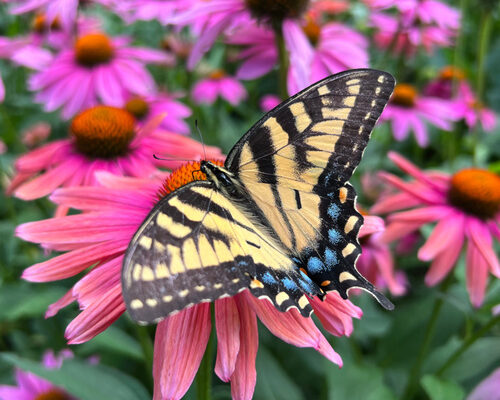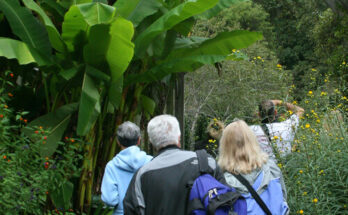Shelley Haefner is sharing a beautiful garden with us today.
One of the best ways to know if you’re planting for pollinators is if you see a continual increase in the varieties that visit. My gardens are organically grown in Old Chatham New York, Zone 5b, where we have a pretty short growing season. Over the last few years, we’ve gone from seeing a few bees and butterflies to seeing a tenfold increase. Part of the reason is the addition of brightly colored perennials and an increased focus on adding the pollinators’ host plants. I thought I’d share my “Perennial Playland,” which attracts the most beautiful visitors to my gardens.
 It’s a riot of color in this ‘Perennial Playland’ garden! This garden is chockful of different varieties for summer color, like coneflowers (Echinacea hybrids, Zones 4–9), daylilies (Hemerocallis hybrids, Zones 4–10), lobelia (Lobelia cardinalis, Zones 3–9), Joe Pye weed (Eupatorium maculatum, Zones 3–8), and more.
It’s a riot of color in this ‘Perennial Playland’ garden! This garden is chockful of different varieties for summer color, like coneflowers (Echinacea hybrids, Zones 4–9), daylilies (Hemerocallis hybrids, Zones 4–10), lobelia (Lobelia cardinalis, Zones 3–9), Joe Pye weed (Eupatorium maculatum, Zones 3–8), and more.
 The patio space planted up with ‘Golden Jubilee’ hyssop (Agastache ‘Golden Jubilee’, Zones 5–8) and mixed with the Giant Benarys zinnias (Zinnia elegans, annual) that I start from seed is very popular with the butterflies and bees.
The patio space planted up with ‘Golden Jubilee’ hyssop (Agastache ‘Golden Jubilee’, Zones 5–8) and mixed with the Giant Benarys zinnias (Zinnia elegans, annual) that I start from seed is very popular with the butterflies and bees.
 Baby hummingbirds learning to eat for the first time sip from different plants and stop for a rest on Adobe Orange coneflowers.
Baby hummingbirds learning to eat for the first time sip from different plants and stop for a rest on Adobe Orange coneflowers.
 Multiple visitors enjoy the ‘Mama Mia’ coneflowers.
Multiple visitors enjoy the ‘Mama Mia’ coneflowers.
 Eastern tiger swallowtail on ‘Mama Mia’ coneflower
Eastern tiger swallowtail on ‘Mama Mia’ coneflower
 Syrphid fly on Pow Wow Wild Berry coneflowers. (Yes, this looks like a hornet at first glance. Many flies mimic the look of bees and hornets so predators will leave them alone. But syrphid flies don’t sting and are excellent pollinators.)
Syrphid fly on Pow Wow Wild Berry coneflowers. (Yes, this looks like a hornet at first glance. Many flies mimic the look of bees and hornets so predators will leave them alone. But syrphid flies don’t sting and are excellent pollinators.)
 Bumblebees frequently visit Kismet Intense Orange coneflowers, along with various skippers.
Bumblebees frequently visit Kismet Intense Orange coneflowers, along with various skippers.
 Black swallowtails visit these zinnias that I’ve mixed in with dill in the vegetable garden. Dill is one of the host plants for their caterpillars.
Black swallowtails visit these zinnias that I’ve mixed in with dill in the vegetable garden. Dill is one of the host plants for their caterpillars.
 Even the the daylilies get some attention!
Even the the daylilies get some attention!
 We also have a healthy and diverse population of dragonflies.
We also have a healthy and diverse population of dragonflies.
 Fritillary on ‘Ice Ballet’ milkweed (Asclepias incarnata ‘Ice Ballet’, Zones 3–9)
Fritillary on ‘Ice Ballet’ milkweed (Asclepias incarnata ‘Ice Ballet’, Zones 3–9)
You can find more of my garden journey on Facebook (GreenThumbDesigner), Instagram (@guiding_green_thumbs), or YouTube (Guiding Green Thumbs).
Have a garden you’d like to share?
Have photos to share? We’d love to see your garden, a particular collection of plants you love, or a wonderful garden you had the chance to visit!
To submit, send 5-10 photos to [email protected] along with some information about the plants in the pictures and where you took the photos. We’d love to hear where you are located, how long you’ve been gardening, successes you are proud of, failures you learned from, hopes for the future, favorite plants, or funny stories from your garden.
Have a mobile phone? Tag your photos on Facebook, Instagram or Twitter with #FineGardening!
Do you receive the GPOD by email yet? Sign up here.
Source link
Originally posted 2022-08-16 15:01:24.




